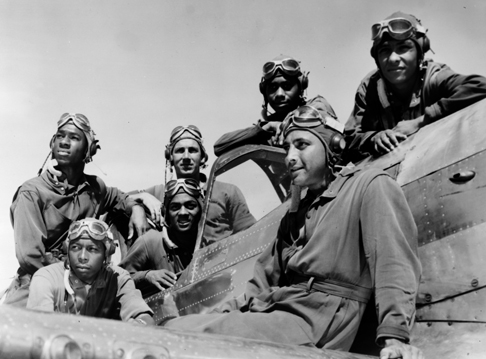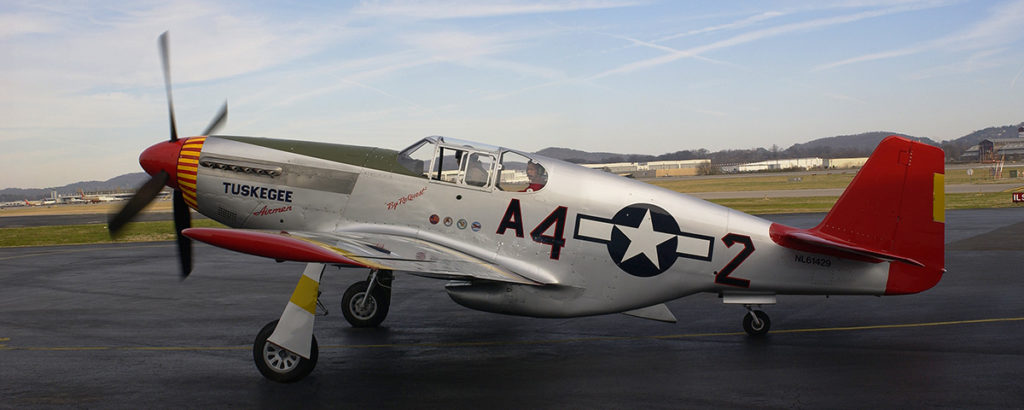By Erin Harney
Alabama NewsCenter

The Tuskegee Airmen National Historic Site
The Tuskegee Airmen National Historic Site is at Moton airfield, near Tuskegee. The airfield served as the primary training site for every African-American U.S. Army Air Corps pilot during World War II. The National Park Service (NPS) began managing the site in 1998.
Moton Field was developed in 1941, with the support of First Lady Eleanor Roosevelt and the Rosenwald Fund. After Mrs. Roosevelt flew with Charles Anderson, the head of pilot training at Tuskegee, the photographs of her, and her positive remarks, encouraged support for African-American aviation.
Today, six of the original structures have been preserved, including one of the original airplane hangars and the Skyline Club, a recreational facility that served all military ranks and civilians.
Brief history of the Tuskegee Airmen
Following the successful flights of Wilbur and Orville Wright in 1903, the field of aviation took off in the early 20th century. According to the U.S. Army Aviation Museum, the Wright brothers, under a directive from President Theodore Roosevelt, were commissioned to develop the U.S. Army’s first military airplane, which debuted in 1909.
In the late 1930s, as tensions grew prior to World War II, Congress passed the Civilian Pilot Training (CPT) Act. The act funded CPT programs throughout the country to train a large number of pilots who could be readied quickly for military service. The Tuskegee Institute was one of the schools included in the CPT. Tuskegee’s success established the school as the South’s premier flight training center for African-Americans.
During this time, the U.S. Army Air Corps (AAC) barred African-Americans’ entrance into flight training, under the premise that they could not meet the high standards needed for military aviation. However, in 1939, Public Law 18 required the ACC to contract with civilian flight schools to train military pilots. The Tuskegee Institute (now Tuskegee University) was awarded the ACC contract to provide flight training for African-Americans.

The first Tuskegee squadron to leave for battle in World War II was the 99th Fighter Squadron. Its pilots served as patrol and bomber mission escorts in North Africa in 1943. The 99th Fighter Squadron did not lose a bomber in 180 missions. The next flight squadron, the 332nd Fighter Group, was sent to Italy in early 1944, and shot down at least 17 enemy aircraft. According to the NPS, both squadrons “quickly gained a reputation as excellent escort units. Bomber crews called them the ‘Red Tail Angels’ because of their planes’ distinctive red tail section and because they were known to never abandon bombers in their care.”
The 477th Bombardment Group never saw combat, but members’ peaceful protest of segregated officers’ clubs and the impressive records of the 99th and 332nd squadrons encouraged President Harry Truman to sign an executive order calling for “equality of treatment and opportunity for all persons in the armed services without regard to race, color, religion, or national origin.”
According to the NPS, “The Tuskegee Airmen sprang from an experiment conducted by the ACC to see if Negroes (primarily African-Americans) had the mental and physical capabilities to lead, fly military aircraft, and the courage to fight in war. The term Airmen was not limited to pilots, (and) included technicians, radio operators, supply personnel, medical personnel, parachute riggers, mechanics, bombardiers, navigators, meteorologists, control tower operators/dispatchers, cooks, and (others). Included also were the Caucasian military personnel who oversaw base operations, as well as native-Americans, Caribbean islanders, Latinos, and people of mixed racial heritage.”



